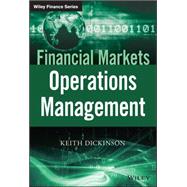Financial Market Operations Management offers anyone involved with administering, maintaining, and improving the IT systems within financial institutions a comprehensive text that covers all the essential information for managing operations. Written by Keith Dickinson—an expert on the topic—the book is comprehensive, practical, and covers the five essential areas of operations and management including participation and infrastructure, trade life cycle, asset servicing, technology, and the regulatory environment. This comprehensive guide also covers the limitations and boundaries of operational systems and focuses on their interaction with external parties including clients, counterparties, exchanges, and more.
This essential resource reviews the key aspects of operations management in detail, including an examination of the entire trade life cycle, new issue distribution of bonds and equities, securities financing, as well as corporate actions, accounting, and reconciliations. The author highlights specific operational processes and challenges and includes vital formulae, spreadsheet applications, and exhibits.
- Offers a comprehensive resource for operational staff in financial services
- Covers the key aspects of operations management
- Highlights operational processes and challenges
- Includes an instructors manual, a test bank, and a solution manual
This vital resource contains the information, processes, and illustrative examples needed for a clear understanding of financial market operations.








